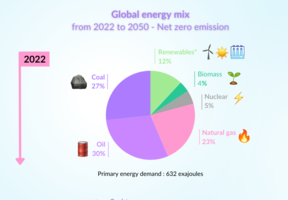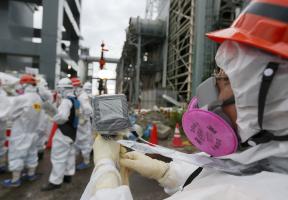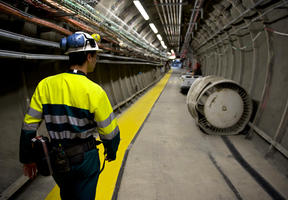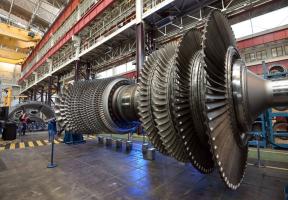The Nuclear Fuel Cycle
5 min read
A gray, hard and very dense metal, natural is widely found in the Earth's crust associated with other chemical compounds, both in granitic and sedimentary soils. But before it can be used in a , it must undergo several forms of processing. This is the front-end of the cycle. After the fuel is used in the reactor, it again goes through a series of steps known as the back-end of the cycle1.

© AREVA - TAILLAT JEAN-MARIE - To increase its uranium content, ore is processed into a yellow pasty concentrate called yellowcake, which is then used in the production of nuclear fuel.
Commercial-grade deposits, which can be easily identified by the radiation they emit, contain between 100 grams and 10 kilograms of uranium per metric ton of ore. Extraction takes place either in underground or open-pit mines, or in situ, with into the soil of an acid or alkali solution that dissolves the uranium, which is then pumped out.
In conventional mining, ore slabs are crushed, ground and chemically processed. The resulting concentrate is called yellowcake, due to its color and pasty texture. Yellowcake contains about 75% uranium.
In 2020, the estimated that known conventional resources, recoverable at an acceptable cost (less than $260 per kg), amounted to about 8 million metric tons. Depending on future developments in the sector, annual demand for uranium is expected to stand at between 50,000 and 100,000 metric tons. This would lead us to estimate the availability of reserves for a period of 80 to 200 years.
Enrichment
Natural uranium contains 99.3% uranium-238 (U-238) and 0.7% uranium-235 (U-235). However, most nuclear reactors use as fuel uranium containing between 3% and 5% uranium-235. The concentration of U235 in natural uranium therefore needs to be increased, or "enriched".
To do this, a gaseous phase is required to convert the uranium into uranium hexafluoride (UF6). Enrichment is achieved through two main industrial processes:
- Gaseous diffusion, which consists in passing the gas through porous membranes. Being lighter, the U-235 molecules cross the barrier more easily than the U-238 molecules. Repeating the operation a great number of times yields uranium hexafluoride with the desired concentration of U-235. This highly method is currently being phased out.
- Centrifugation, which is becoming increasingly widespread, uses centrifuges turning at extremely high speed. The heaviest molecules (U-238) are projected to the outer edges and the gas enriched with the lighter U-235 is recovered in the central part before being re-injected. A "cascade" of several hundred centrifuges is required to completely carry out the process.
Fuel production
France and most of the world's nuclear plants are pressurised water reactors. Here, Enriched uranium hexafluoride (UF6) is converted into uranium oxide in the form of a black powder. This is then compressed into pellets which are baked at 1,700°C to reach the required density. A pellet weights 7 grams and releases as much energy as a metric ton of .
The pellets are then inserted in metal tubes about four meters long. The two ends are plugged to create a fuel rod containing about 300 pellets. The rods are then grouped together in a metal structure to make a . Each assembly has about 250 rods. At this stage, the fuel is ready to be brought to the heart of the nuclear reactor.
Back-end of the fuel cycle
Once it has been consumed in the reactor for at least three years, the spent fuel contains various forms of uranium and plutonium (9 kg per metric ton) but also products from the fission of heavy nuclei and . Through different reprocessing techniques, 96% of this spent fuel can be recycled. It can be reused either by manufacturing a fuel called MOX (a mixture of uranium and plutonium), by re-enriching uranium from reprocessing or, in the event of the development of fast reactors, by using a fuel based on depleted uranium and plutonium.
These techniques also reduce the quantities to be stored. The remaining 4% waste is high- and intermediate-level radioactive waste with a long half-life. This final waste cannot yet be recycled.
In the 1970s, France opted to reprocess spent fuel. The main objectif of this technology was to save on raw materials, reduce the radiotoxicity of waste and build up a stock of plutonium that could be used to fuel future fast neutron reactors using depleted uranium. This scheme commits France to the circular economy by , reusing and recovering materials. Other countries that master this technology on an industrial scale include the United Kingdom and Japan (the Japanese plant is currently shut down). The other countries with nuclear reactors either recycle or have recycled their spent fuel after reprocessing in France or the United Kingdom, or plan to store it like other radioactive waste.





















